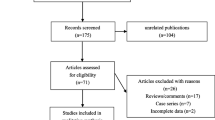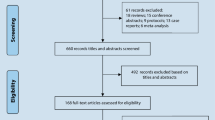Abstract
The researches attempting to associate the PPARγ C161T polymorphism with coronary artery disease (CAD) yielded complicated and contradictory results. We aimed for more precise estimate of the relationship and conducted a comprehensive meta-analysis. Publications written in English or Chinese were screened in MEDLINE, Embase, CNKI, Wanfang and CBM. Data on 11 studies including 3,020 cases and 2,853 controls were extracted. A random-effects model was available to synthesize the inconsistent outcomes of the individual studies, while addressing between-study heterogeneity and publication bias. The PPARγ C161T polymorphism followed Hard-Weinberg Equilibrium for all studies (P > 0.05).Overall, there was no evidence for a significant association under all genetic models but with distinct heterogeneity (T vs. C: P = 0.29, OR = 0.91, 95 %CI 0.77–1.08, P heterogeneity = 0.004, I 2 = 61.2 %). However, in the subgroup analysis by ethnicity, the T allele carriers showed a prominent 26 % risk reduction of CAD among Chinese (dominant genetic model: P = 0.03, 95 %CI 0.57–0.97, P heterogeneity = 0.03, I 2 = 56.1 %). After dividing into population source, the significance of CAD risk reduction was strengthened in hospital-based studies (allele comparison: P = 0.04, OR = 0.82, 95 %CI 0.67–1.00, P heterogeneity = 0.04, I 2 = 52.5 %; dominant model: P = 0.01, OR = 0.73, 95 %CI 0.57–0.92, P heterogeneity = 0.05, I 2 = 50.8 %). There was no obvious publication bias verified in the method of funnel plot and Egger’s linear regression test (t = −0.11, P = 0.913). Taken together, our results revealed the PPARγ C161T polymorphism might play a moderate protective effect on developing CAD among Chinese, but not among Caucasians.





Similar content being viewed by others

References
Roger VL, Go AS, Lloyd-Jones DM, Benjamin EJ, Berry JD et al (2012) Heart disease and stroke statistics–2012 update: a report from the American Heart Association. Circulation 125:e2–e220
Expert Panel on Detection E, Treatment of High Blood Cholesterol in A (2001) Executive summary of the third report of the National Cholesterol Education Program (NCEP) expert panel on detection, evaluation, and treatment of high blood cholesterol in adults (Adult Treatment Panel III). JAMA 285:2486–2497
Zdravkovic S, Wienke A, Pedersen NL, Marenberg ME, Yashin AI et al (2002) Heritability of death from coronary heart disease: a 36-year follow-up of 20 966 Swedish twins. J Intern Med 252:247–254
Duval C, Chinetti G, Trottein F, Fruchart JC, Staels B (2002) The role of PPARs in atherosclerosis. Trends Mol Med 8:422–430
Fisman EZ, Tenenbaum A (2009) A cardiologic approach to non-insulin antidiabetic pharmacotherapy in patients with heart disease. Cardiovasc Diabetol 8:38
Kota BP, Huang TH, Roufogalis BD (2005) An overview on biological mechanisms of PPARs. Pharmacol Res 51:85–94
Wahli W, Michalik L (2012) PPARs at the crossroads of lipid signaling and inflammation. Trends Endocrinol Metab 23:351–363
Huang JV, Greyson CR, Schwartz GG (2012) PPAR-gamma as a therapeutic target in cardiovascular disease: Evidence and uncertainty. J Lipid Res 53(9):1738–1754
Fahmi H, Martel-Pelletier J, Pelletier JP, Kapoor M (2011) Peroxisome proliferator-activated receptor gamma in osteoarthritis. Mod Rheumatol 21:1–9
Moffett SP, Feingold E, Barmada MM, Damcott CM, Marshall JA et al (2005) The C161– > T polymorphism in peroxisome proliferator-activated receptor gamma, but not P12A, is associated with insulin resistance in Hispanic and non-Hispanic white women: evidence for another functional variant in peroxisome proliferator-activated receptor gamma. Metabolism 54:1552–1556
Dongxia L, Qi H, Lisong L, Jincheng G (2008) Association of peroxisome proliferator-activated receptorgamma gene Pro12Ala and C161T polymorphisms with metabolic syndrome. Circ J 72:551–557
Wright RS, Anderson JL, Adams CD, Bridges CR, Casey DE Jr et al (2011) 2011 ACCF/AHA focused update incorporated into the ACC/AHA 2007 Guidelines for the Management of Patients with Unstable Angina/Non-ST-Elevation Myocardial Infarction: a report of the American College of Cardiology Foundation/American Heart Association Task Force on Practice Guidelines developed in collaboration with the American Academy of Family Physicians, Society for Cardiovascular Angiography and Interventions, and the Society of Thoracic Surgeons. J Am Coll Cardiol 57:e215–e367
Joensen AM, Jensen MK, Overvad K, Dethlefsen C, Schmidt E et al (2009) Predictive values of acute coronary syndrome discharge diagnoses differed in the Danish National Patient Registry. J Clin Epidemiol 62:188–194
Anderson JL, Adams CD, Antman EM, Bridges CR, Califf RM et al (2011) 2011 ACCF/AHA Focused Update Incorporated Into the ACC/AHA 2007 Guidelines for the Management of Patients With Unstable Angina/Non-ST-Elevation Myocardial Infarction: a report of the American College of Cardiology Foundation/American Heart Association Task Force on Practice Guidelines. Circulation 123:e426–e579
Cohn LD, Becker BJ (2003) How meta-analysis increases statistical power. Psychol Methods 8:243–253
Lau J, Ioannidis JP, Schmid CH (1997) Quantitative synthesis in systematic reviews. Ann Intern Med 127:820–826
Higgins JP, Thompson SG (2002) Quantifying heterogeneity in a meta-analysis. Stat Med 21:1539–1558
Higgins JP, Thompson SG, Deeks JJ, Altman DG (2003) Measuring inconsistency in meta-analyses. Br Med J 327:557–560
Egger M, Davey Smith G, Schneider M, Minder C (1997) Bias in meta-analysis detected by a simple, graphical test. Br Med J 315:629–634
Ramsey DM, Futschik A (2012) DNA pooling and statistical tests for the detection of single nucleotide polymorphisms. Stat Appl Genet Mol Biol 11: Article 1
Peng DQ, Zhao SP, Nie S, Li J (2003) Gene-gene interaction of PPARgamma and ApoE affects coronary heart disease risk. Int J Cardiol 92:257–263
Wan J, Xiong S, Chao S, Xiao J, Ma Y et al (2010) PPARgamma gene C161T substitution alters lipid profile in Chinese patients with coronary artery disease and type 2 diabetes mellitus. Cardiovasc Diabetol 9:13
Wang XL, Oosterhof J, Duarte N (1999) Peroxisome proliferator-activated receptor gamma C161– >T polymorphism and coronary artery disease. Cardiovasc Res 44:588–594
Liu Y, Yuan Z, Zhang J, Yin P, Wang D et al (2007) PPARgamma gene C161T substitution is associated with reduced risk of coronary artery disease and decreased proinflammatory cytokine expression. Am Heart J 154:718–724
Bluher M, Klemm T, Gerike T, Krankenberg H, Schuler G et al (2002) Lack of association between peroxisome proliferator-activated receptor-gamma-2 gene variants and the occurrence of coronary heart disease in patients with diabetes mellitus. Eur J Endocrinol 146:545–551
Zhou X, Chen J, Xu W (2012) Association between C1431T polymorphism in peroxisome proliferator-activated receptor-gamma gene and coronary artery disease in Chinese Han population. Mol Biol Rep 39:1863–1868
Doney AS, Fischer B, Leese G, Morris AD, Palmer CN (2004) Cardiovascular risk in type 2 diabetes is associated with variation at the PPARG locus: a Go-DARTS study. Arterioscler Thromb Vasc Biol 24:2403–2407
Dallongeville J, Iribarren C, Ferrieres J, Lyon L, Evans A et al (2009) Peroxisome proliferator-activated receptor gamma polymorphisms and coronary heart disease. PPAR Res 2009:543746
Chao TH, Li YH, Chen JH, Wu HL, Shi GY et al (2004) The 161TT genotype in the exon 6 of the peroxisome-proliferator-activated receptor gamma gene is associated with premature acute myocardial infarction and increased lipid peroxidation in habitual heavy smokers. Clin Sci (Lond) 107:461–466
Yilmaz-Aydogan H, Kurnaz O, Kurt O, Akadam-Teker B, Kucukhuseyin O et al (2011) Effects of the PPARG P12A and C161T gene variants on serum lipids in coronary heart disease patients with and without Type 2 diabetes. Mol Cell Biochem 358:355–363
Evangelisti L, Attanasio M, Lucarini L, Sofi F, Marcucci R et al (2009) PPARgamma promoter polymorphisms and acute coronary syndrome. Atherosclerosis 205:186–191
Colhoun HM, McKeigue PM, Davey Smith G (2003) Problems of reporting genetic associations with complex outcomes. Lancet 361:865–872
Whitehead A (2003) Meta-analysis of controlled clinical trials. Wiley, Chichester
Attia J, Thakkinstian A, D’Este C (2003) Meta-analyses of molecular association studies: methodologic lessons for genetic epidemiology. J Clin Epidemiol 56:297–303
Hemminki K, Lorenzo Bermejo J, Forsti A (2006) The balance between heritable and environmental aetiology of human disease. Nat Rev Genet 7:958–965
Su J, Qi Y, Liu S, Wu X, Lv J et al (2012) Revealing epigenetic patterns in gene regulation through integrative analysis of epigenetic interaction network. Mol Biol Rep 39:1701–1712
Bjornsson HT, Fallin MD, Feinberg AP (2004) An integrated epigenetic and genetic approach to common human disease. Trends Genet 20:350–358
Salanti G, Sanderson S, Higgins JP (2005) Obstacles and opportunities in meta-analysis of genetic association studies. Genet Med 7:13–20
Munafo MR, Flint J (2004) Meta-analysis of genetic association studies. Trends Genet 20:439–444
Stroup DF, Berlin JA, Morton SC, Olkin I, Williamson GD et al (2000) Meta-analysis of observational studies in epidemiology: a proposal for reporting. Meta-analysis Of Observational Studies in Epidemiology (MOOSE) group. J Am Med Assoc 283:2008–2012
Kimchi-Sarfaty C, Oh JM, Kim IW, Sauna ZE, Calcagno AM et al (2007) A “silent” polymorphism in the MDR1 gene changes substrate specificity. Science 315:525–528
Meirhaeghe A, Fajas L, Helbecque N, Cottel D, Lebel P et al (1998) A genetic polymorphism of the peroxisome proliferator-activated receptor gamma gene influences plasma leptin levels in obese humans. Hum Mol Genet 7:435–440
Dragojević JMJMB (2008) Association between Pro12Ala and His477His polymorphisms in PPARG gene and insulin resistance in patients with polycystic ovary syndrome. Biochemia Medica 18:342–350
Acknowledgments
This work was supported by the Shanghai excellent young teachers training fund of colleges and universities (jdy09097) and the science and technology fund of Shanghai Jiao Tong University School of Medicine (11XJ21001).
Conflict of interest
The authors have declared that no competing interests exist.
Author information
Authors and Affiliations
Corresponding author
Additional information
Zhijun Wu, Yuqing Lou contributed equally to this work.
Rights and permissions
About this article
Cite this article
Wu, Z., Lou, Y., Jin, W. et al. The C161T polymorphism in the peroxisome proliferator-activated receptor gamma gene (PPARγ) is associated with risk of coronary artery disease: a meta-analysis. Mol Biol Rep 40, 3101–3112 (2013). https://doi.org/10.1007/s11033-012-2384-3
Received:
Accepted:
Published:
Issue Date:
DOI: https://doi.org/10.1007/s11033-012-2384-3



